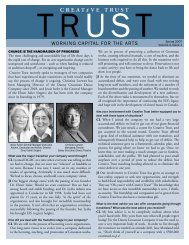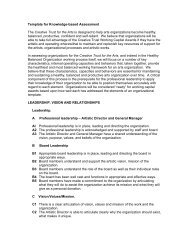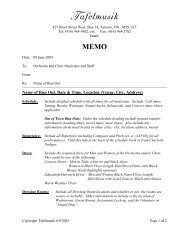20 Questions - Canadian Institute of Chartered Accountants
20 Questions - Canadian Institute of Chartered Accountants
20 Questions - Canadian Institute of Chartered Accountants
You also want an ePaper? Increase the reach of your titles
YUMPU automatically turns print PDFs into web optimized ePapers that Google loves.
Recommended practices<br />
• The organization has stable, well-diversified sources <strong>of</strong> revenue<br />
• The organization is not overly dependent on discretionary government grants<br />
• The organization is prepared to deal with changes in funding levels from one<br />
or more <strong>of</strong> its sources<br />
6. How do events in the organization and the<br />
world outside affect our ability to achieve<br />
the mission and vision?<br />
Before an organization begins to develop its strategies it needs to understand<br />
where it is now. A commonly-used process for doing this is “SWOT analysis”:<br />
Strengths, Weaknesses, Opportunities, Threats. This is a simple model, easy to<br />
understand and use and appropriate for most mid-sized and small not-for-pr<strong>of</strong>it<br />
organizations. SWOT analysis provides a “snapshot” <strong>of</strong> how well the organization<br />
is positioned to achieve its vision and mission.<br />
Strengths and weaknesses are related to the internal factors and resources<br />
that support the organization’s ability to get things done: staff, volunteers,<br />
membership, finances, donor support, buildings, equipment, etc. They describe<br />
the capacity <strong>of</strong> the organization to continue and extend its activities and the<br />
problems that need attention. The review <strong>of</strong> strengths and weaknesses should<br />
include the systems for providing the financial, statistical and other information<br />
needed to support the organization’s ability to effectively manage its resources<br />
and deliver services.<br />
An organization’s strengths and weaknesses are usually in matters over which<br />
its board and management have some degree <strong>of</strong> control. Lists <strong>of</strong> strengths and<br />
weaknesses are <strong>of</strong>ten developed by group brainstorming by staff and, where<br />
appropriate, volunteers. In the process they draw on their experience and<br />
knowledge <strong>of</strong> the organization and consultation with stakeholders. The board<br />
may confirm or add to the list.<br />
Adapting strategies to<br />
changing needs and opportunities<br />
The War Amps was founded in 19<strong>20</strong> as The Amputations Association<br />
<strong>of</strong> The Great War, a fraternal society that provided direction to help<br />
solve the problems <strong>of</strong> all “men and women who have lost a limb or<br />
limbs or complete eyesight whilst giving their service to Canada, the<br />
British Empire, and the Allies in the Great War.” Counselling, self-help<br />
and practical assistance were emphasized.<br />
The Civilian Liaison Program began in 1953 in order that war<br />
amputees could share their knowledge with others who are missing<br />
limbs from causes other than war.<br />
Realizing that war amputees were being well served by existing<br />
programs and that in the future their needs would decrease, the<br />
organization turned its attention to child amputees. In 1975 it<br />
started the Child Amputee (CHAMP) Program which tries to reach<br />
all amputee children and their families as soon after an amputation<br />
as possible, providing artificial limbs, education and counselling to<br />
help the children cope with their amputations. War Amps has also<br />
introduced accident awareness programs to reduce the incidence <strong>of</strong><br />
amputations.<br />
The organization is now laying the groundwork for the time when war<br />
amputees will no longer be able to run the affairs <strong>of</strong> the Association.<br />
9












